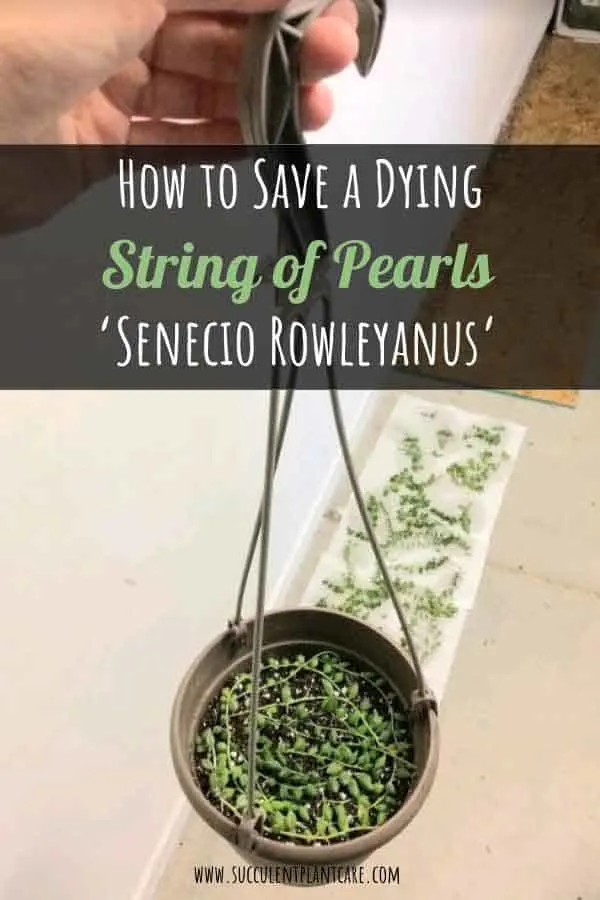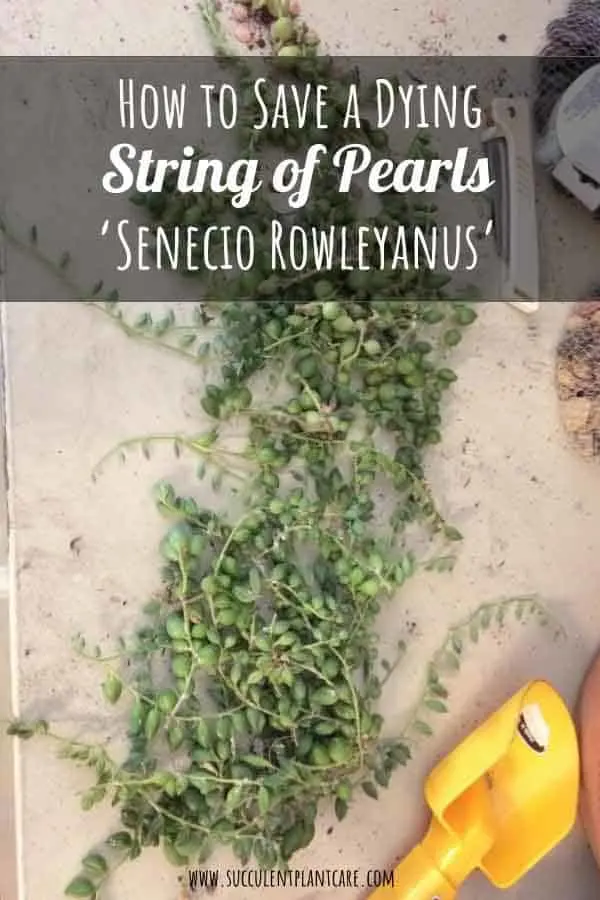String of Pearls are one of my all-time favorites. I just love their plump, round, green leaves. I love how they look as they grow and trail along the sides of the pot.
As much as I love these plants, I have had trouble with growing them in the past. Just as I thought I have figured them out, disaster snuck up on me and by the time I noticed, it was almost too late.

This was one of the first String of Pearls plant that I planted and although the plant was doing really well for a while, problems were brewing underneath the surface. Fortunately, I was able to spot the problems and quickly take action before it was too late to save the plant.
Eight common problems you may encounter growing your String of Pearls are pot is too big, the plant is planted too deep, over watering, under watering, wrong potting mix, too much sun, not enough sun and insects/pests infestation.
Hopefully this will help you avoid a disaster like this one from happening. I also showed how I rescued this plant and brought it back to life.
Eight common problems when growing String of Pearls is easily avoidable, I listed them below.
The Pot is Too Big
Make sure the pot is not too big for the plant. If the pot is too big, the plant can stay wet too long and will eventually cause rotting. String of Pearls have very narrow stems, unlike other succulents, which can make them prone to rot.
The Plant is Planted Too Deep in the Pot
String of Pearls plants do not have deep root systems and they do not require a lot of soil. Too much soil can cause root rot because they stay wet too long and takes longer to dry out. Also, if planted too deep in the pot (more than an inch down), the plant does not get adequate aeration which can promote fungal growth and rot.
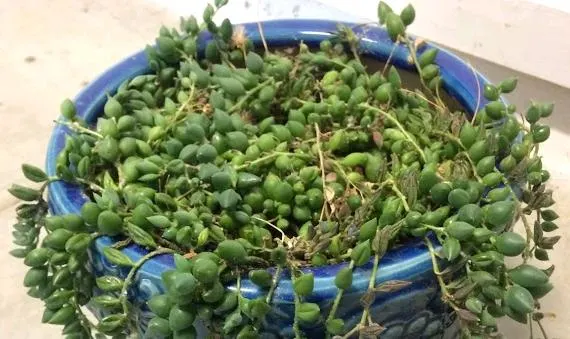
This was the problem with my plant. While I liked how the pot looked, I realized that it was not the best choice for String of Pearls. The pot was too deep and the rim was too thick. These were both bad choices for this type of plant and sure enough, the plant began to suffer.
Over Watering
String of Pearls, unlike other succulents, have very thin stems. They do not store much water in their stems. They store water in the little round leaves. When over watered, these leaves can absorb too much water until they literally burst.
They can have a shriveled, mushy appearance when overwatered. Give it a good drink and as much as possible, aim for the base of the plant and not the crown. Avoid misting the plant. Where I live, the climate is very dry.
I water the String of Pearls once a week during hot summer months, or even more during an intense heat wave. I cut down on watering to about every 10-14 days when it gets cooler. During winter when it rains more, I rely mostly on rainwater since I keep my plants outdoors. If it doesn’t rain much then I water about once every 2 weeks during winter.
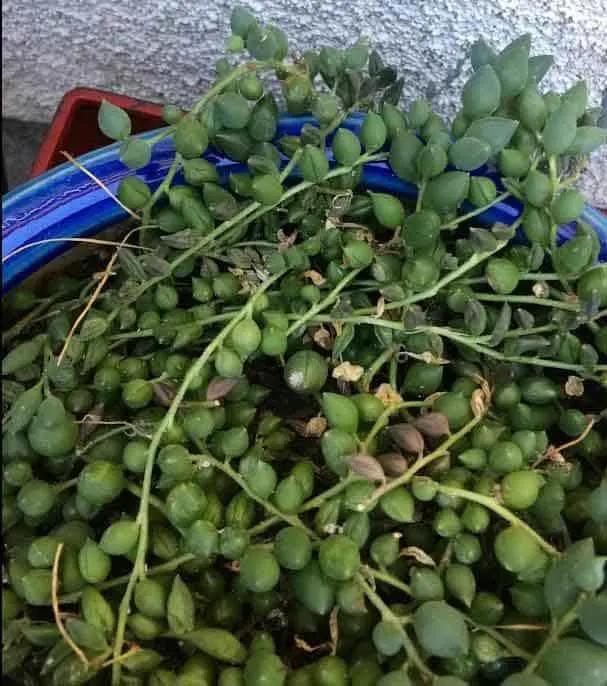
You need to figure out your watering needs based on the climate where you live. Most of the time, people have trouble with overwatering String of Pearls rather than underwatering. There are tools such as moisture meters and hygrometers to check for soil moisture and humidity in the air.
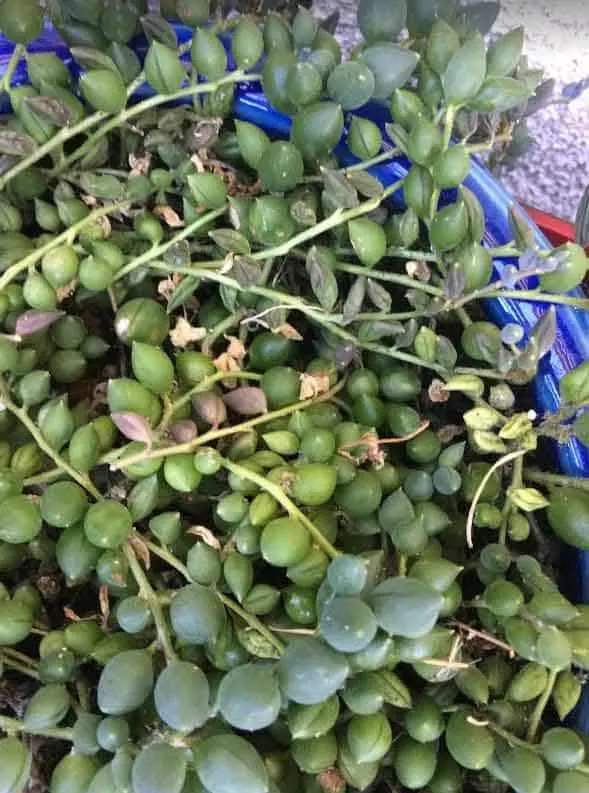
Under Watering
An underwatered String of Pearls will be easy to spot. The leaves will appear shriveled and dried up. Generally speaking, it is easier to fix an underwatering problem than an overwatering one. I tend to underwater my plants for this reason.
Give the plant a good drink of water and it should perk up almost immediately and start looking better. You may need to increase watering if your String of Pearls appear shriveled. For example, If you once a month and notice the leaves start to shrivel, increase watering to once every two weeks and see what happens.
For more on this topic, please click on Why Are My String of Pearls Shriveling?
Wrong Potting Mix
String of Pearls need a well draining soil. If the soil stay wet for too long, this will promote root rot. String of Pearls have very thin roots and stems and are susceptible to rot. Make sure you are using the right soil.
I like to use a commercial cactus and succulent potting mix which I combine with perlite for extra drainage. You can read Best Soil and Fertilizers for more information on this topic.
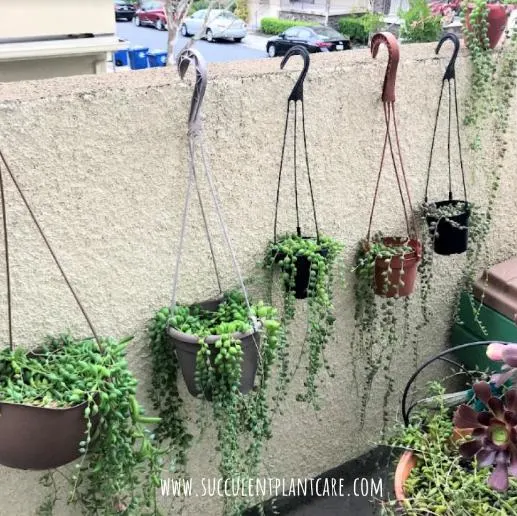
Too Much sun
String of Pearls prefer bright but filtered light. They do not do well under intense sunlight or full sun. Make sure your String of Pearls are protected from the sun’s heat, especially afternoon sun.
Morning sun is less intense and is generally better tolerated. Provide protection or shade to prevent sunburn or sun damage.
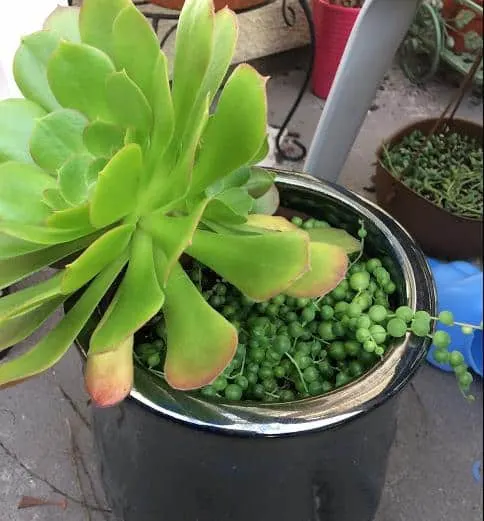
Not Enough Sun
Although they do not like full sun, they do need bright light to thrive. If kept indoors, place in a bright area near the window but shielded from direct sunlight. If you find your plant struggling indoors, it may not be receiving adequate light.
Too little light + too much water is a recipe for disaster. Depending on your location, you may not receive adequate lighting. Or maybe the days are getting shorter. In these cases, consider investing on a growlight to help your plants thrive.
If kept outdoors, place in a shaded area that receives the most light.
Insects or Pests
Aphids and mealybugs like fleshy plants, and String of Pearls are no exception. If you spote a white powdery substance on your plant, those are probably mealybugs. These insects secrete honeydew or a sugary substance, which can promote the growth of mold and make the plan more susceptible to bacterial and fungal infections.
You can usually spot them on the leaves or the underside of leaves, and between the joints of the plant. Aphids are small insects with fat, teardrop-shaped bodies. They can be found sucking on leaves or flowers at the end of the stems.
They expel a sugary white substance or honeydew, as they feed. This sugary substance can encourage the growth of black sooty mold.
A tell tale sign that your plant has an aphid or mealybug infestation is ants. If you see ants, a lot of them, busily working on or around your plant, take a closer look and you’ll see that you have other issues going on. Ants are attracted to the sweet substance these pests produce and will actually protect these pests to keep their food supply going.
Please click on Common Pests on Succulents for treatment ideas.
How to Save Your String of Pearls
If the problem is one of the common problems mentioned above, take action right away and correct the mistake before the plant suffers. If you find your plant dying from the roots, you can still do something to save your plant.
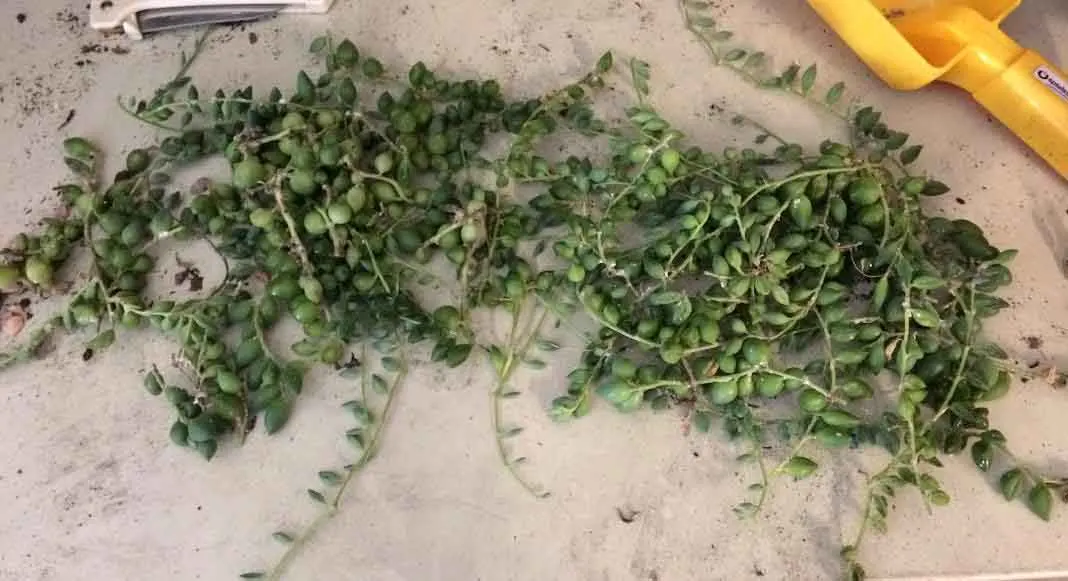
Inspect the plant and see what is salvageable. For me, anything green is still viable and has a chance at surviving.
Remove any dead, black, moldy parts, and dead roots. Trim off any dead parts of the plant.
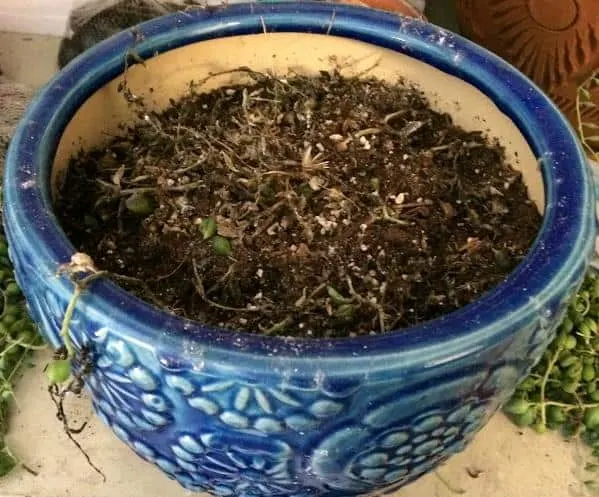
These are the cuttings I was able to salvage. Unlike other succulents, String of Pearls have very thin stems so the cuttings do not need to be dried out before repotting. If you want to be on the safe side, you can wait a couple of hours or a day before repotting.
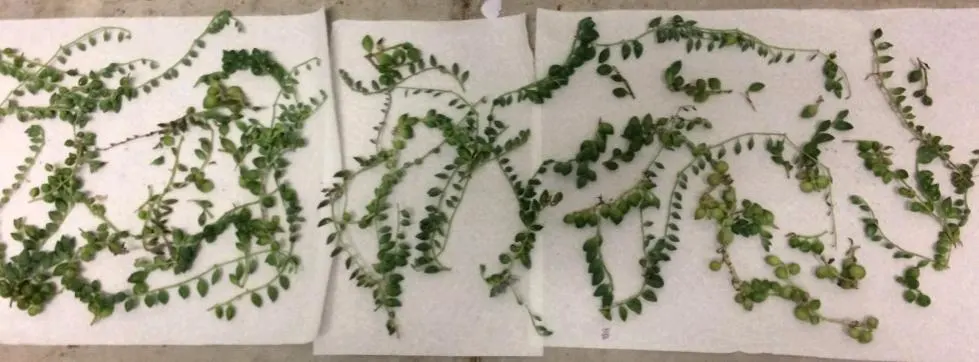
String of Pearls root alongside the stems. It does not matter whether you have the right side up or down, the stem will shoot out roots along the sides of it. You do not have to remember which end to stick in the soil, it doesn’t matter because it will root from where it is touching the soil.
You can stick the stem directly into the soil like this.
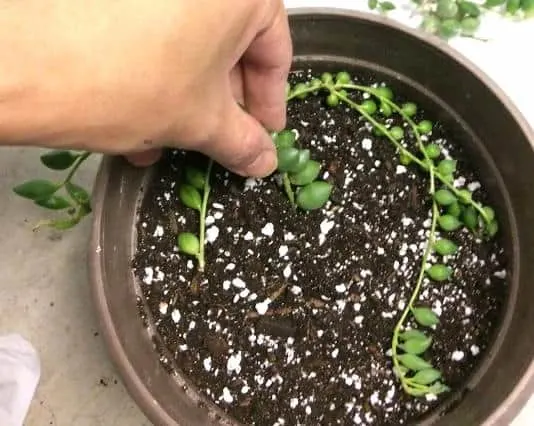
Or you can lay them on the soil sideways like this. This is my preferred method because I like to start with a full crown and I don’t mind waiting for the plant to grow and eventually trail. If you want yours trailing right away then stick one end in the soil and let the other end hang.
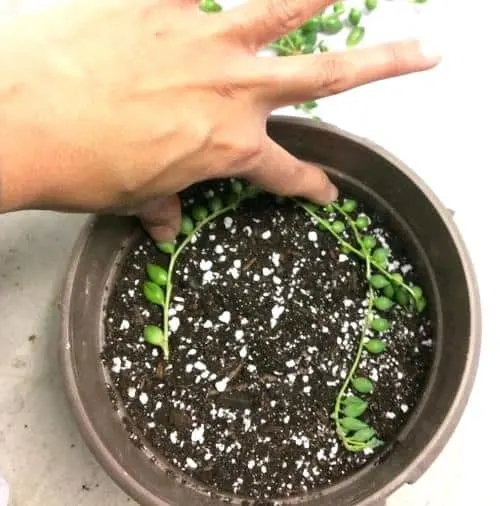
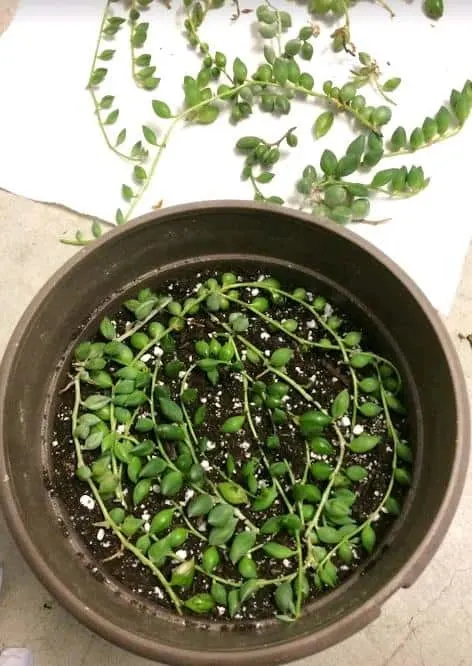
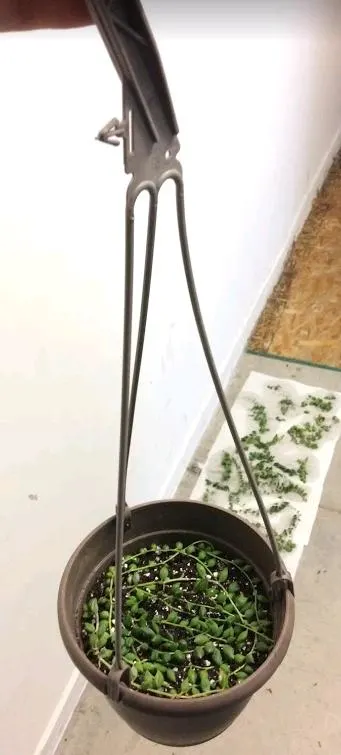
Hopefully, this doesn’t happen to you and you wouldn’t have to save your String of Pearls plant. But if it does, don’t lose heart cause something good might come out of it. I repotted the cuttings that I saved in a few of these containers and in different pots.
Soon I’ll have more plants than I started out with so it’s all good.
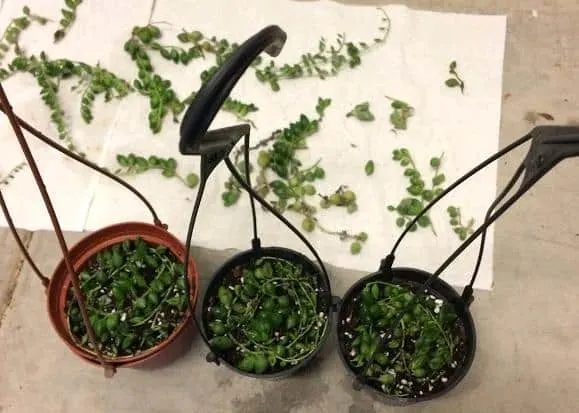
To read more about String of Pearls care and propagation, please click on “What You Need To Know About String of Pearls.”
For other common problems with String of Pearls such as shriveled leaves, click on my post “Why Are My String of Pearls Shriveling?”
Interested in seeing other hanging succulents or cacti? Check out my post “Hanging Succulents.”
Where can you find Senecio Rowleyanus ‘String of Pearls’? Check out my resource page for recommendations on where to purchase these and other succulent plants online.
Pin this to save for later or share with others!
